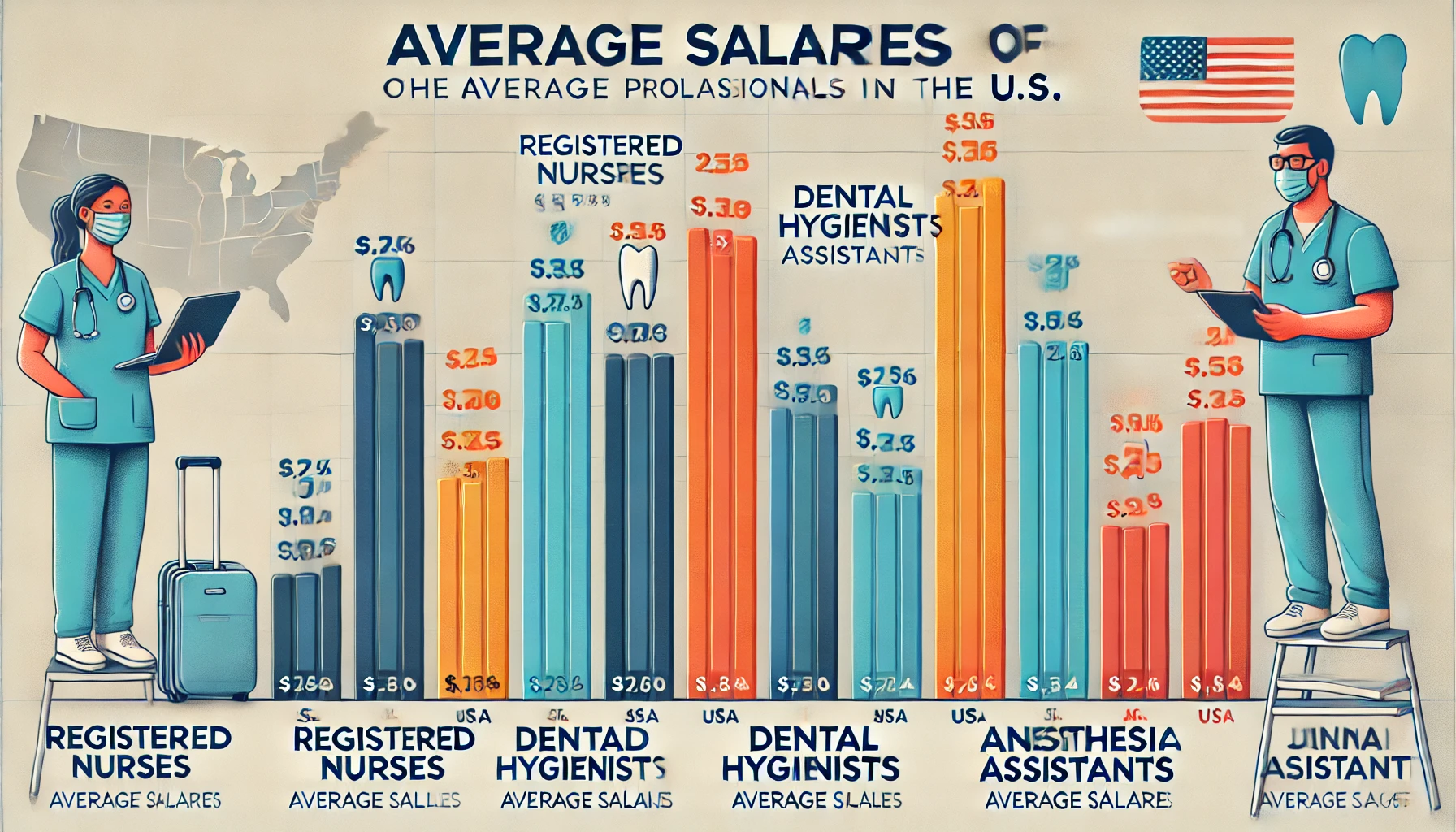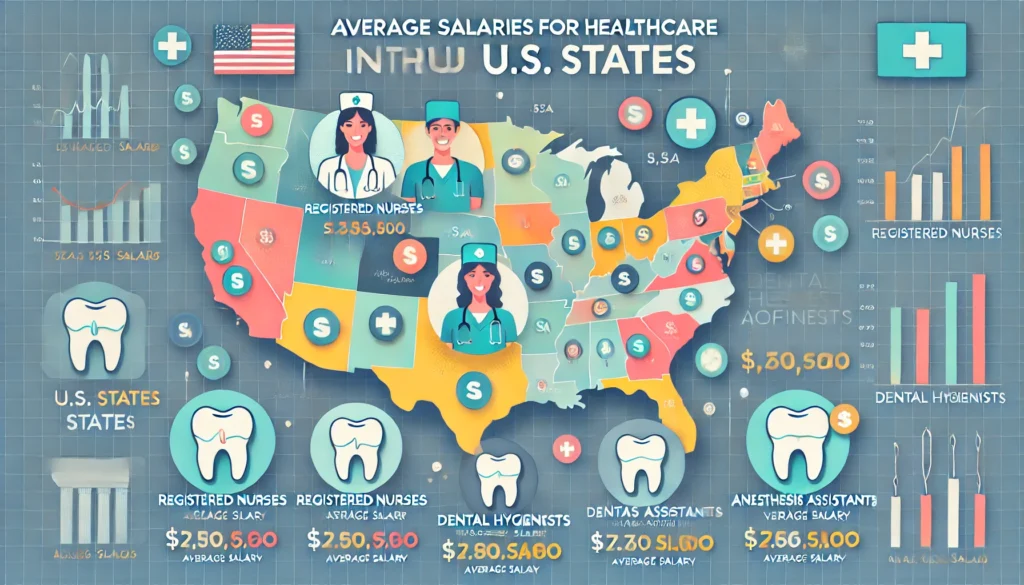In the rapidly evolving healthcare landscape, understanding salary variations among medical professionals is essential for anyone considering or pursuing a career in this field. With significant differences in compensation based on geographic location, it becomes crucial to navigate these disparities effectively. This article will delve into the factors influencing healthcare salary variations in the U.S., offer a state-by-state analysis of average salaries, and provide practical advice for maximizing earnings.
The Importance of Geographic Location in Healthcare Salaries
Why Location Matters
Location significantly influences the salaries of medical professionals. The U.S. consists of diverse regions with unique economic conditions and healthcare needs. Consequently, some states and cities offer higher salaries to compensate for living expenses and demand for healthcare services.
High-Paying States
- California: This state is renowned for its high salaries, particularly for healthcare professionals. Registered nurses can earn upwards of $100,000 annually, especially in cities like San-Francisco and Los Angeles. Check Salary.com.
- Texas: Known for its booming healthcare industry, Texas provides competitive salaries for various medical roles. The state’s population growth drives demand for healthcare services, further enhancing compensation.
- Florida: With a significant elderly population, Florida has a growing demand for healthcare services, resulting in higher salaries for geriatrics and nursing professionals; you can find specific salary insights on Glassdoor.
- Alaska: Despite its high cost of living, Alaska offers attractive salaries for healthcare workers, including dental hygienists, who can earn around $115,050 per year; for detailed salary comparisons, visit Indeed.
- Washington D.C.: The capital boasts lucrative salaries for anesthesia assistants and other medical professionals, often exceeding $100,000 due to the concentration of healthcare institutions; explore salary trends on PayScale.
Professionals can explore healthcare salary variations across the U.S. and consider locum tenens roles for flexible, high-earning opportunities to maximize income potential.

Salary Comparison Across States
Understanding the average salaries of medical professionals in various states helps make informed career decisions. Here’s a comparison of average salaries:
| State | Average Salary for Registered Nurses | Average Salary for Dental Hygienists | Average Salary for Anesthesia Assistants |
|---|---|---|---|
| California | $100,000+ | $110,970 | $150,000 |
| Texas | $75,000 – $85,000 | $75,000 – $90,000 | $115,000 |
| Florida | $70,000 – $80,000 | $75,000 – $85,000 | $100,000 |
| Alaska | $85,000 – $100,000 | $115,050 | $130,000 |
| Washington D.C. | $85,000 – $95,000 | $102,380 | $155,000 |
Factors Influencing Salary Variations in Healthcare
Cost of Living Considerations
The cost of living is a major factor that affects salaries across the United States. States with high living expenses often offer higher salaries, but it’s essential to assess whether those salaries sufficiently cover the costs of housing, transportation, and other daily expenses.
- Housing Costs: In states like California and New York, housing can consume a significant portion of income. Therefore, while salaries may be high, professionals must carefully budget to accommodate these costs; for detailed information on housing trends, visit the American Hospital Association.
- Utilities and Transportation: In addition to housing, costs for utilities, transportation, and groceries can vary dramatically between states. Understanding these costs helps evaluate overall compensation.
Demand for Healthcare Services
The demand for healthcare services can drive salaries higher in specific regions. States experiencing population growth or a higher percentage of elderly residents typically see increased demand for healthcare services.
- Elderly Population: States like Florida and Arizona have large retiree populations, leading to a robust demand for healthcare services such as nursing and geriatrics. Explore demographic trends on the National Center for Health Statistics.
- Urban Growth: States like Texas and Colorado are experiencing rapid urbanization, increasing the need for healthcare professionals. This demand results in higher wages due to competition for skilled workers.

State Regulations and Healthcare Policies
State regulations significantly impact salary structures for healthcare professionals. For example, states that allow nurse practitioners to practice independently often report higher salaries for these professionals due to increased demand.
- Licensing Requirements: Stringent licensing requirements may limit the number of professionals in a state, increasing demand and salary levels. States with more accessible licensing processes can attract more professionals and stabilize salaries. For insights into licensing requirements, check Healthcare Financial Management Association.
- Scope of Practice Laws: These laws define what healthcare professionals can do, impacting their earning potential. States that provide broader scopes for practice often see higher compensation for these roles.
Urban vs. Rural Salary Differences
Rural and Urban settings exhibit notable salary disparities. Urban areas usually offer higher wages due to greater demand for healthcare services and a concentration of healthcare facilities.
- Higher Salaries in Urban Areas: Cities like New York and Los Angeles tend to pay more due to the Increased demand for medical services. However, the cost of living in these areas is also significantly higher. For more information on salary trends, visit The Balance Careers.
- Opportunities in Rural Areas: While salaries may be lower in rural regions, healthcare professionals can benefit from loan forgiveness programs and a lower cost of living. Moreover, the demand for healthcare services in these areas can result in job security and a fulfilling lifestyle.

Identifying Growing Markets for Medical Professions
Identifying states or regions with growing markets can enhance career prospects. States experiencing an influx of healthcare jobs include:
- North Dakota and South Dakota: These states face shortages in various healthcare roles, leading to competitive salaries and incentives for new hires.
- Nevada: With a growing population and expanding healthcare infrastructure, Nevada offers opportunities for medical professionals looking to relocate.
Opportunities for Career Advancement
Healthcare professionals should focus on areas that pay well and provide opportunities for career growth. Consider the following strategies:
- Continuing Education: Additional certifications or degrees can increase earning potential and open doors to higher paying positions.
- Networking: Intriguing with professional organizations and attending conferences can provide valuable connections and insights into job opportunities in high-paying states.
Building a strong professional network is essential for career growth in healthcare. With insights from Transform Healthcare Networking, discover how effective networking can transform your career.

Real-Life Experiences from Healthcare Professionals
Case Study 1: Sarah’s Journey
Sarah, a registered nurse from Ohio, decided to move to California for better salary prospects. Despite the higher living costs, her annual income increased by nearly 30%. Sarah noted that her financial situation improved significantly, allowing her to repay student loans faster while enjoying the vibrant California lifestyle. Her experience underscores the importance of assessing salary and living costs before moving.
Case Study 2: Mark’s Experience
Mark, a dental hygienist, relocated to Alaska for their impressive salary. Although the initial transition was challenging due to the remote location, he discovered a strong sense of community and a supportive work environment that enhanced his quality of life. Mark’s story illustrates that the right location can lead to professional and personal satisfaction.
For those looking to explore ways to enhance their earnings further, consider reading our article on how to double your dental hygienist salary here potentially.
Frequently Asked Questions (FAQs)
What are the states with the highest pay for healthcare professionals?
California, Alaska, and Washington, D.C., are the highest-paying states. These states offer competitive salaries due to high demand and living costs.
How do I determine if relocating is worth it?
Consider factors such as salary, cost of living, job demand, and personal lifestyle preferences. Researching potential employers and connecting with local professionals can provide valuable insights.
Are there financial incentives for moving to rural areas?
Many rural healthcare positions offer student loan forgiveness programs and relocation bonuses to attract healthcare professionals to underserved regions.
What impact do state regulations have on salaries?
State regulations can influence salaries by determining the scope of practice for medical professionals, impacting job demand and overall compensation.
How can I maximize my gaining potential as a healthcare professional?
Continuing education, obtaining certifications, and considering relocation to high-demand areas can significantly increase your earning potential.
Conclusion
Understanding healthcare salary variations among medical professionals in the U.S. is essential for making informed career decisions. Geographic location, cost of living, service demand, and state regulations all contribute to these differences. By conducting thorough research and considering factors outlined in this article, healthcare professionals can identify the best opportunities to maximize their earnings and enhance their quality of life.
For more insights on boosting your career in the healthcare field, be sure to check out our other articles tailored to help you succeed.








84 réflexions au sujet de “Understanding Healthcare Salary Variations Among Medical Professionals in the U.S.”